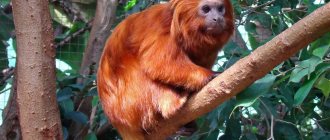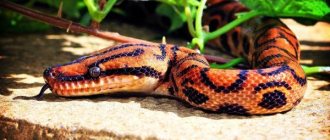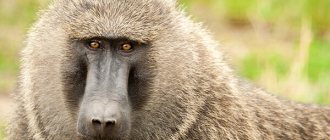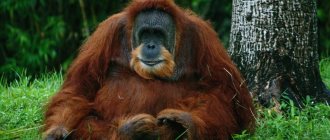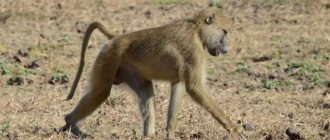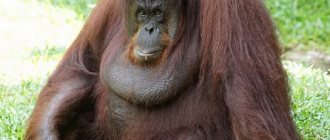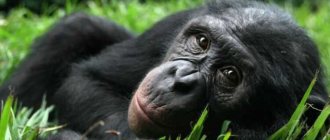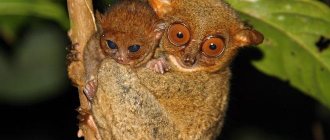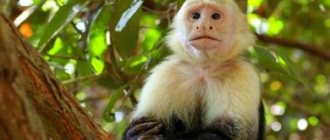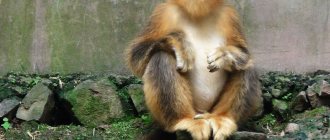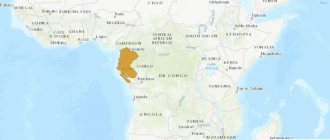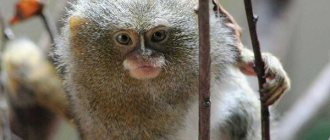Did you know that the noisiest primate is the howler monkey? The Colombian and loud-voiced representative of these animals more than once terrified the conquistadors.
Ecuador, Guatela, Mexico, Nicaragua, Panama, Colombia, Costa Rica - in these territories you can meet an unusual representative of primates - the Colombian howler monkey. The stocky, large animal belongs to the family of capuchins or prehensile-tailed monkeys. With its extraordinary appearance, the howler monkey has earned great popularity, which, however, did not save it from the risk of extinction. Today, the monkey needs human protection and help.
Colombian Howler
Appearance of a howler
The monkey’s body is quite large: in males the body length reaches 63 cm, and in females - 46-60 cm. The tail is grasping and strong, has a length of 60-70 cm in males, and 55-66 cm in females. The weight of the animal is also impressive: males weigh 5-10 kg, and females - 3-8 kg. Closed nostrils and large thirty-six teeth give the animal a ferocious appearance. The Colombian howler monkey is usually black in color, with long golden-red fur growing on both sides of the body, like a mantle.
There is a bald patch at the end of the grasping tail, which the monkey uses to grab food. In adult males, the color of the scrotum changes from black to white. Males have a long beard, which distinguishes them from females. Hairless areas include the ears, face, palms and feet.
The howler monkey is one of the most harmless monkeys for humans. They are not only afraid of people. Very rarely do they even descend from tall trees.
Capuchins
This genus of monkeys includes more than thirty subspecies. The species of these primates form four groups. These monkeys live in Brazil and Honduras. They spend most of their time on the tops of tall trees. The body length of the animal reaches fifty centimeters. The head is round, with prominent cheekbones. The color of the muzzle is usually pink or white. On the top of the head there is a black crest, similar to the hood of the Capuchin monks (in fact, because of this similarity the animal got its name).
Primates live in groups of 10 to 30 individuals. They work together to obtain food, defend themselves from enemies, and take care of their offspring. Capuchins are omnivores: they feed on both plant and animal foods. It should be noted that these monkeys are very smart. They can crack nuts with a stone and beat fruits on tree branches. Having caught a tree frog, they clean off the mucus from it by wiping it on a tree. Capuchin cubs spend all their time on their mother’s back for up to three months, crawling onto their chest to feed on milk. From the age of six months, they begin to lead a more independent lifestyle, eat adult food, but do not stray far from their mother.
Listen to the voice of a howler monkey
With their noise, animals “communicate” with their relatives, informing them of their location. For their loud voice, howler monkeys should be grateful to their throat bone, which allows them to be heard at a distance of up to three kilometers.
A female howler monkey with her calf. It’s quite comfortable for the baby to travel riding on mommy’s back.
Species: Cynocephalus volans Linnaeus = Philippine woolly wing, kaguan, flying maquis
Area
The Philippine woolly wing lives on the Philippine oceanic islands: Mindanao, Basilan, Samar, Leyte, Bohol.
In terms of lifestyle, the kaguan is completely arboreal. They live in a multi-tiered rain forest. They are also often found in coconut and rubber plantations.
The weight of the Philippine woolly wing is from 1 to 1.75 kg (according to other sources - up to 2.2 - 3.85 kg). In appearance, they resemble real lemurs (maquis), which, unlike the woolly wing, do not fly. They are similar in size to a cat and slightly smaller than the Malaysian flying lemur. The fur is usually darker in color and less spotted than that of the Malaysian woolwing. They have huge eyes and faces that resemble Old World bats. The head is wide, the animal has rounded short ears and a blunt muzzle. Limbs of equal length, with strong claws for climbing tree trunks and branches.
The kaguan's toes are connected by a leather membrane. This membrane of skin connects the various structures of the body and extends from the side of the animal's neck to the tips of the fingers and toes and continues all the way to the tip of the tail. No other gliding mammal has such extensive flight skin membranes.
The combination of unusual and varied incisors (teeth) makes them similar to herbivorous mammals such as cattle and deer. The upper incisors and canines are positioned on the sides of the jaw, leaving a gap at the front of the jaw so they are not positioned against the protruding lower incisors. The lower incisors are comb-shaped with 20 comb-like projections emanating from a single root, which allows the animal to make scraping movements when feeding, and such teeth also help in grooming and cleaning the fur. The molars retain the characteristic features of insectivores and are designed for grinding tough food, including the transverse action of the jaw. This action of strong tooth enamel ensures effective chewing of tough plant material. The dental formula is: 2 / 3, 1 / 1, 2 / 2, 3 / 3 = 34.
Pregnancy lasts on average about 105 days. The baby is born weighing an average of 38.50 g (1.36 oz). Usually one young caguan is born, but sometimes twins are born. The child is born in an underdeveloped state (altricial). The baby is attached to the mother's belly, where he spends his entire childhood.
The Philippine woolly wing is a crepuscular animal, so it seeks shelter in the form of hollows in tree trunks, in which it hides during the day. Their feeding activity is highest before sunset and several hours before sunrise. They glide from tree to tree, rising to the top of the tree, and then jump down, gliding through the air. They have good control over their gliding, typically landing at the bottom of another tree's trunk and then climbing up to the top to begin a new gliding cycle. To move up the tree trunk, they grab the trunk with outstretched fingers of the limbs. During movement, the front legs are placed together, while the hind legs are spread apart. The distance over which woolly wings can easily glide is up to more than 100 meters.
The diet of the Philippine woolly wing consists mainly of leaves, buds, and flowers of various tree species. Most of the time, they prefer to eat young leaves because young leaves have higher nutritional value than older leaves. They can also eat fruit and drink juice. In general, they prefer larger trees to feed on because larger trees produce more young leaves and other food sources. When feeding, kaguanas use their enlarged tongue and specialized lower incisors to gnaw on delicate parts of leaves.
The stomach of the Philippine woolly wing specializes in ingesting large quantities of leafy plants. The intestines are long and confusing. Their guts can be up to 4 meters long. The area of pyloric digestion, located near the exit from the stomach, is enlarged and divided into compartments. These chambers are inhabited by microorganisms that help break down cellulose and convert it into other, relatively easily digestible carbohydrates.
The negative value for humans of the Philippine woolly wing as a pest, according to plantation owners, is that their diet contains fruits, leaves, and flowers.
On the other hand, the Philippine Woolwing is hunted for its meat. Although the Philippine woolly wing is not in direct danger of extinction, it is threatened by deforestation and loss of suitable habitats.
Where does the loud howler monkey live?
The habitat of these singers is wooded areas of varying altitudes. Lowland and mountainous rain regions are no exception. Recently, a massive migration of monkeys to coffee plantations has been recorded, namely to the southern part of Mexico.
The peculiar structure of the larynx gives the howler monkey unique vocal abilities. This factor also affects the appearance of the primate.
Range, habitats
The little-studied red-handed howler monkey (Alouatta belzebul) is endemic to Brazil, found in the southeastern Amazon and coastal forest areas between Sergipe and Rio Grande do Norte. The black howler monkey (Alouatta caraya) is found in the northeastern part of Argentina, in the eastern territories of Bolivia, in the east and south of Brazil or in Paraguay, and along with the brown howler monkey, this species is classified as the southernmost of all representatives of the numerous genus.
The Guyanese howler monkey (Alouatta macconnelli), a relatively recently identified species, is found throughout the Guiana Highlands, north of the Amazon, east of the Rio Negro and south of the Orinoco, and its habitat may also extend closer to the south from the Amazon territory, in the areas between the Madeira and Tapajos rivers.
This is interesting! The Coib Howler (Alouatta coibensis) has two subspecies and is endemic to Panama, while the Brown Howler (Alouatta guariba) lives primarily in forested areas in southeastern Brazil and is also found in northeastern Argentina.
Representatives of the species Amazonian howler monkey (Alouatta nigerrima) were considered a subspecies of the red-handed howler monkey some time ago. They live in areas belonging to central Brazil. The Bolivian howler monkey (Alouatta sara) lives in northern and central Bolivia, up to the borders with Peru and Brazil. The Central American howler monkey (Alouatta pigra) is found in rainforest areas of Belize, Mexico and Guatemala. The red howler monkey (Alouatta seniculus) is a very typical inhabitant of the territories stretching from the Amazon to Colombia, from central Bolivia to Ecuador.
Return to content
What does a howler monkey eat?
The diet of these animals is quite varied: from flowers to large snakes. They also prefer mammals, birds and insects. During wet seasons, howler monkeys will not refuse fruits. The animal can eat several leaves, plant shoots and fruits per day. Their stomach is designed in such a way as to process cellulose correctly and quickly. Thanks to this, the animal can eat only leaves and flowers for weeks, and the body will not lack trace elements.
Natural enemies
People hunt almost all existing species of howler monkeys for their delicious and very exotic, expensive meat. The cubs of such unusual primates are actively caught by poachers and sold as popular pets.
This is interesting! The most common natural enemies of howler monkeys include the puma, ocelot, harpy eagle, or monkey-eater, which is capable of attacking monkeys directly from the air, and also often snatches small cubs from the backs of their mothers.
The mammal population is suffering greatly from destruction in its natural habitat, and active road construction work in the natural habitat of howler monkeys contributes to the obvious and rapid fragmentation of the habitat.
Return to content
Lifestyle of noisy primates
The males begin the “choral” singing, and then the females pick up the general singing.
Howler monkeys are known to be active during the daytime. They spend most of their time in trees. The monkey spends up to 75% of its time resting. Howler monkeys devote the rest of their time to feeding. During dry seasons, animals make transitions and migrations. This is mainly due to a decrease in food sources. The tail helps them move and move through the trees, and they also use it to grab food. They live in groups or families, do not build nests, preferring to live directly on the branches of the upper tier. They don’t like to go down to earth, they are afraid to swim.
Seeing a howler monkey on the ground is a very rare sight.
Nutrition
Red howler monkeys feed on fruits and leaves, mainly young ones. The leaves have less nutritional value than the fruits, however, the long intestine of howler monkeys, which occupies a third of the body, has two sections where bacteria that digest cellulose live. The powerful lower jaw of howler monkeys is also used for chewing leaves. These monkeys spend almost their entire lives in the upper layer of the tropical forest, where they feed on leaves, flowers, various seeds and nuts, as well as fruits.
Reproduction of howler monkeys
When the female's vaginal lips turn red, the males know it is breeding time. In the middle of this period, mating occurs. The female attracts her male with a rhythmic mating dance. The female gives birth to one cub, which weighs 400-500 g. The cub has a gray-golden fur color, which soon darkens. Until the age of 6 months, the child does not part with his mother and only at the age of one year does he take his first independent steps.
Young howler monkeys are learning the ropes of tree climbing.
Lifestyle
Woolly wings are predominantly nocturnal. They spend the day in the hollows of trees or hanging on branches, with their membrane unfolded like a cloak.
The woolly wing is so adapted to the arboreal lifestyle that when it finds itself on the ground, it becomes completely clumsy and crawls in a hurry to quickly find itself again in its native arboreal element.
Caguanas prefer to live alone. They are territorial; each animal is assigned a certain area of the forest.
Woolly wings make sounds reminiscent of the cries of ducks, but most often babies “talk” this way; adults rarely do this.
What do kaguanas eat?
The kaguan menu mainly consists of leaves, buds, shoots, flowers, and sometimes soft fruits. In addition, they often lick sap from tree trunks. While feeding, the animal pulls a branch with leaves towards itself until it reaches them with its front paws, and then tears off the foliage with its strong tongue and lower incisors.
Reproduction
Caguans do not have a specific breeding season. Pregnancy lasts about 60 days, after which a tiny baby weighing only about 35 grams is born. The mother feeds the baby with milk for up to six months. Lactating females can be pregnant at the same time, i.e. births follow one after another. The cubs are born underdeveloped, like marsupials, and during the feeding period they are located on the mother’s stomach. The membrane near the tail can be folded into a soft, warm pocket, in which the mother carries the baby. When the female is resting, hanging from a branch with a straightened membrane, a small woolly wing crawls out of this “hammock.” The cub reaches adult size no earlier than 2-3 years of age.
Enemies
The amazing flying machine of the kaguana is suitable for traveling long distances. But it also has a drawback - it makes the animals vulnerable to birds of prey. Among the natural enemies of the woolly wing is one of the rarest birds in the world - the Philippine harpy monkey-eater (woolwings make up more than 90% of its diet).
Benefits and harms for humans
There is no harm from these animals to humans. But the benefit is that the local population hunts howler monkey meat. These monkeys are also known to be used for scientific purposes.
The animal today is on the verge of extinction. The howler monkey is listed under CITES as a primate in decline. One problem that affects this is a specific disease caused by a parasitic fly on the howler monkey's throat.
Just cute.
If you find an error, please select a piece of text and press Ctrl+Enter.
Why are they roaring?
The screams of these monkeys are considered the loudest in the animal kingdom. They can be heard 1.6 km away. Charles Darwin hypothesized that among vertebrates, the male who screams the loudest demonstrates his strength and attracts the attention of the largest number of females. This assumption has been confirmed for some species of frogs, but for howler monkeys there is not yet sufficient evidence to assert this.
According to another theory, a herd of howler monkeys claims rights to fruit trees with their cries. This assumption seems to be true, but the evolutionary background of growling requires further study. In recent years, studies of howler monkeys' lifestyles have been conducted in Central and South America to answer these questions.
Howler monkeys produce their war cry by blowing air through a cavity in the enlarged hyoid in the throat. The laryngeal cartilage in males is much larger than in females. The sounds made by males of different species depend on the size of the cartilage. The male red howler monkey has larger laryngeal cartilage than the Colombian howler monkey. The cry of the first resembles a deep martyr's groan, while that of the second resembles a roar.
All males of the herd conduct a pre-dawn “choral singing”, which is responded to by males of other herds. The territories occupied by howler monkey herds partially overlap with the territories of other herds. When males call in the morning, and also every time the herd moves to a new feeding area, they thereby transmit information about their location to neighboring herds.
When two herds meet, an unimaginable uproar arises. All individuals, especially adult males, begin to roar, jump, run, and sometimes fight. Females from both herds scatter and sometimes get lost in the forest. Apparently, it is precisely in order to avoid unnecessary skirmishes between herds that the males roar.
Howler monkeys have a hierarchy between different herds. It is based on the fighting qualities and coordination of actions of adult males. By listening to the roar of the males of a strong herd, the weaker ones can avoid a collision with them and save their strength. But a strong herd also benefits, since its members do not have to protect fruit trees.
Thus, the purpose of the roar is to help the monkeys make the best use of their living space and not suffer from food shortages.
Particular danger for howler monkeys
Primates do not cause harm. In nature, due to their habitat, they have almost no enemies. The main danger: the local population. Hunters kill howler monkeys to satisfy their food needs. Sometimes primates are used for scientific purposes. Among the natural dangers of the wild world, only one can be singled out - the parasitic fly. It lives on the throat of the howler monkey, which causes a specific disease. The outcome of such an “acquaintance” between a primate and an insect is the death of the howler monkey.
Video
Links[edit]
- Jump up
↑ Groves, C. P. (2005). Wilson, DE; Reader, D. M. (ed.). Mammal Species of the World: A Taxonomic and Geographical Guide (3rd ed.). Baltimore: Johns Hopkins University Press. pp. 148–152. ISBN 0-801-88221-4. OCLC 62265494. - Jacobs, G. H.; Neitz, M.; Deegan, J.F.; Neitz, J. (1996). "Trichromatic color vision in New World monkeys". Nature
.
382
(6587): 156–158. DOI: 10.1038/382156a0. PMID 8700203. - Lucas, P. W.; N. J. Dominy (2003). "Evolution and function of routine trichromatic vision in primates". Evolution
.
57
(11):2636–43. DOI: 10.1554/03-168. PMID 14686538. - ^a b Dunn, JC; Galenar, LB; Davis, T. G.; Cristobal-Azkarate, J.; Reby, D.; Sykes, D.; Dengg, S.; Fitch, W. T.; Knapp, L. A. (2015). "Evolutionary trade-off between vocal tract and testicular size in howler monkeys". Current Biology
.
25
(21): 2839–44. DOI: 10.1016/j.cub.2015.09.029. PMC 4635310. PMID 26592343. - ^ abc Sussman R. (July 2003). Ecology and Social Structure of Primates, Vol. 2: Monkeys of the New World, revised first edition
. Pearson Prentice Hall. pp. 142–145. ISBN 978-0-536-74364-0. - ↑
Crockett (October 2, 1997).
"Family Feuds" In Chocheon, RL; Nisbett, R. A. (ed.). An Anthology of Primates, The: Essays on Primate Behavior, Ecology and Conservation from Natural History
. Prentice Hall. paragraph 32. ISBN 978-0-13-613845-7. - "Black Howler Monkey". Smithsonian National Zoo and Conservation Biology Institute
. April 4, 2016. Retrieved February 12, 2022. - Glander, Kenneth E. (March 1977). "Poison in the Monkey's Garden of Eden" (PDF). Natural History
.
86
: 146–151. - [1], additional text.
How smart can an orangutan be?
Published by: Leo 04|01|2016 ||
Agree, not every person would think of building a hammock like this while sitting in a cage using a blanket. But this smart orangutan could. Don't believe he did it himself? Then watch the video below...
Usually animals adapt to the existing conditions, but not this orangutan! He came up with an unusual way for a monkey to make himself comfortable. And once again he confirmed that the smartest animals on our planet are apes. One can imagine what kind of resort he would have arranged for himself if there had been something else under his paw other than a blanket!
Recommended viewing:
Resourceful baboons, with the help of a barrel, escaped from the laboratory where they now live in the eighth generation (video) Now monkeys come out for barbecue too! Sapper rat awarded gold medal for discovering dozens of mines in Cambodia
Sensation: chimpanzees in Africa invented some kind of god and pray to him
Published by: Leo 05|03|2016 ||
This is truly a sensation. For the first time, scientists saw the emergence of religion not in people, but in animals! Namely, a group of chimpanzees in Africa, without any reason, began to build pyramids of stones in empty trunks of old trees.
Video cameras recorded how everything happened. Old males approach the “holy” place, throw another stone into the empty tree trunk with a loud cry, and then leave with reverence. What is most amazing is that after they place the stone, the chimpanzees sway from side to side for several seconds, making movements completely unusual for them. It looks like they are praying or meditating. The journal Scientific Reports writes about this. Scientists believe that chimpanzees invented some kind of religion for themselves; piles of stones became its symbol, and empty trunks of old trees became proto-temples.
Recommended viewing:
Why don't Jews and Muslims eat pork, but Christians do? The religious Roman gambit: why the Romans needed Christianity, and how it saved Europe from destruction “Tower of Silence”: a terrible place on earth
